Nord Stage 4 Buyer's Guide for Live Performers
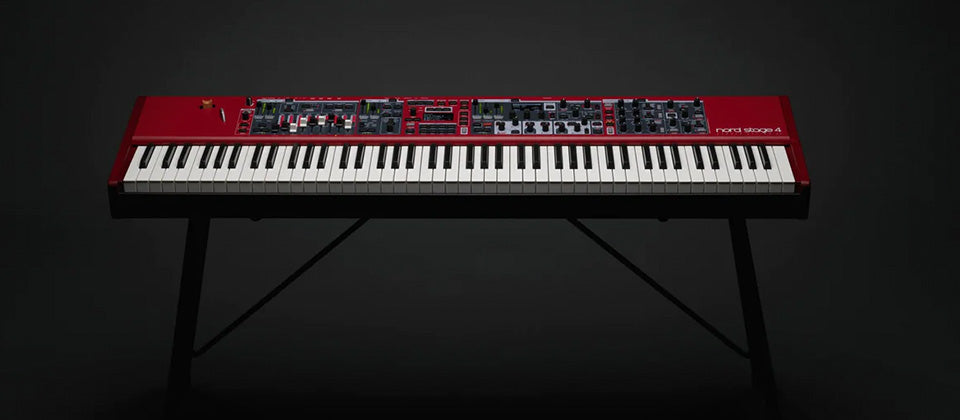
Introduction
Welcome to our detailed Nord Stage 4 Buyer's guide, a must-read for anyone planning on using this flagship Nord for live performance - whether on stage or in the studio.
In this article, Bonners’ keyboard specialist Tony White runs through the basic concept and workflow of the Nord Stage range of keyboards, explains the main features of the Nord Stage 4 and explains how to create & store layer & split keyboard voice combinations. As a regular Nord user, Tony also has a host of tricks & tips to share, which we hope you’ll find useful whether you're new to Nord Keyboards or an experienced user.
Nord Stage 4 Buyer's Guide for Live Performers

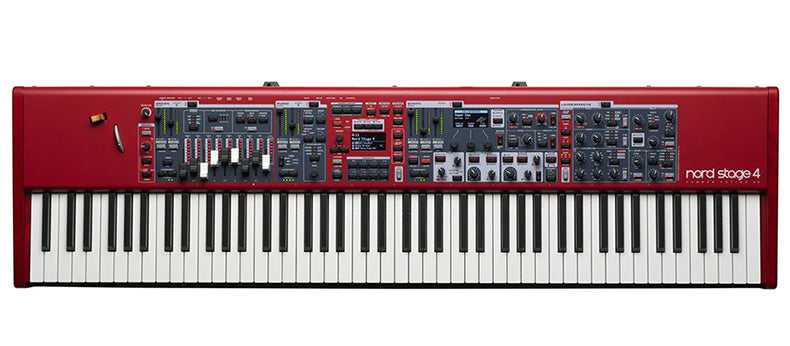
The Nord Stage 4: A Quick Overview
Before we get too deep into the technical aspects of the Nord Stage 4, let's take a look at some basic things you need to know about this premium performance keyboard.
The Nord Stage 4 range has been created to be the ultimate performer's instrument. It's available in three keyboard options, including both 73 and 88-key-weighted hammer actions, as well as a compact 73-note synth-weighted waterfall keybed.
There are various Nord accessories available at extra cost, including wheeled carry cases, keyboard stands, music rest, pedals, and even matching Nord red monitor speakers.
Nord Stage 4 Buyer's Guide for Live Performers

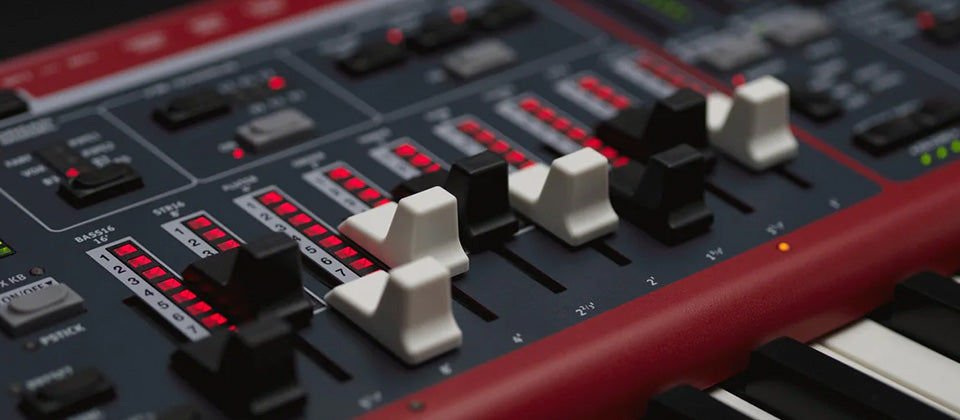
The Nord Stage: a True Live Performers' Keyboard
There are two things that players love about Nord keyboards. Firstly, the sound. These keyboards just cut through the mix of a band like no other instrument. If you're a keys player on stage, no doubt you'll have experienced a situation where it's your turn to do a dynamite solo, and you play your heart out, only to be told by someone in the audience after the gig that they couldn't hear you!
Of course, this has something to do with amplification, but my experience as a regular live keys player has been that many keyboards simply don't have the basic guts in their sound samples or digital-to-analogue convertors to break through the frequencies that you're frequently in competition with on stage from guitarists, bass players and drummers.
Nord Stage 4 Buyer's Guide for Live Performers

The second thing performers rave about is how hands-on the Nord Stage range is: you’ll find a wealth of knobs, sliders and buttons at your disposal to make changes quickly whilst you're performing, with very little menu diving through the screen.
In fact, I have counted a total of 136 physical controllers on the front panel and, rather than being overwhelming, this actually makes the Nord Stage keyboards incredibly intuitive to use. One of my favourite features of the Nord Stage is how easy it is to add & remove sound layers in real time whilst actually playing the keyboard.
Nord Stage 4 Buyer's Guide for Live Performers

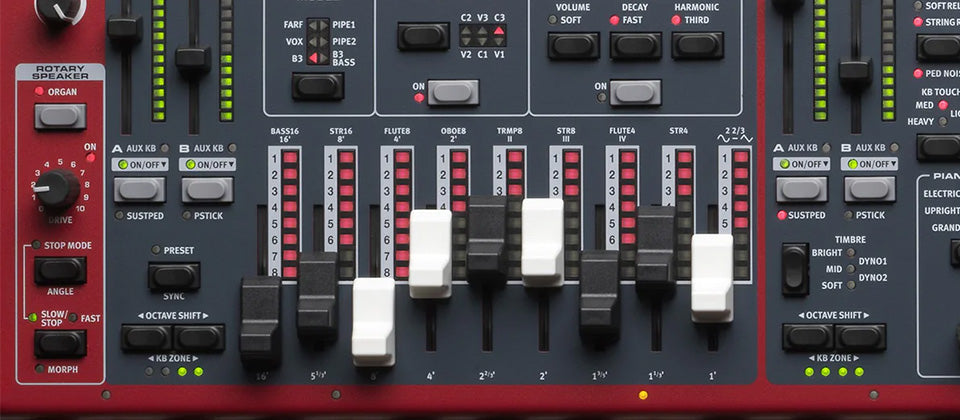
Sound Engines & Dedicated Effects Processor
The Nord Stage 4 has three separate sound engines and a dedicated effects processor, which are clearly laid out on the front panel.
In the central area of the control panel, you'll find the bright OLED display, which clearly tells you which sounds you've got selected and, beneath this, there are eight buttons for selecting different programs. A program is a complete snapshot of the instrument and includes which sounds are selected, split points, controller assignments, effects and lots of other parameters. It's possible to store a total of 512 programs in the Stage 4's memory, which should be ample for most situations - whether you're playing live on stage, at home, or in the studio.
The Stage 4 also features a full set of independent effect chains for each of the seven layered sound parts, something never before seen on a Nord Stage keyboard. This offers players the ability to, for example, use a phaser on an electric piano and a completely different phaser effect on a layered synth part. Or use two completely different types of reverb on different sounds which are active at the same time.
Nord Stage 4 Buyer's Guide for Live Performers

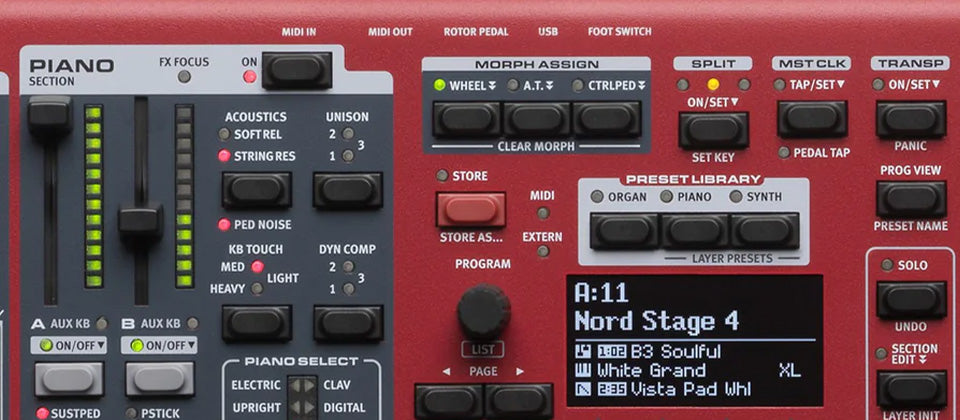
Nord Stage 4 Piano Section
As you can imagine, this monster keyboard can produce some pretty impressive sounds. Let’s start with the piano section.
Having been a Nord Stage 3 player for the last six years, I can honestly say there is a big improvement in the keyboard response on the Stage 4, and you especially notice this when playing the piano voices.
The triple-sensor Hammer action keyboard is the same as Nord uses on their Piano 5 premium stage pianos, and it does feel absolutely lovely to play. Even the semi-weighted waterfall keyboard of the Stage 4 compact 73 has a triple sensor mechanism to capture as much of your playing nuances as possible. A particular favourite of mine is a voice called Hifi Grand, a beautiful piano voice based on the sample of a Yamaha S6 studio grand.
Nord Stage 4 Buyer's Guide for Live Performers

Shop Nord Stage 4 at Bonners
Nord Stage 4 Buyer's Guide for Live Performers

There are six different types of piano voices available from the front panel, including Grand, Upright, Electric, Clav, Digital, and Miscellaneous - which is where you'll find some tuned percussion voices such as marimba and vibraphone.
It is possible to layer two different piano voices together within the piano section, which means you can create some of the sounds made famous by artists such as David Foster or Elton John. You may have seen a video I created a couple of years ago which shows you how to create that legendary Elton John stage piano sound, and I'm pleased to say that I can get even better results with the Nord Stage 4.
Nord Stage 4 Buyer's Guide for Live Performers

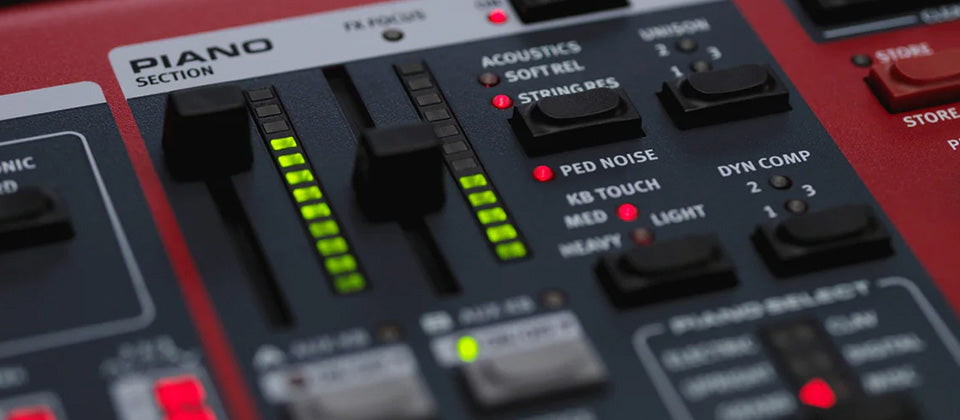
Piano Samples
The Piano Section allows you to select different piano samples using the LIST knob, and it is also possible to add string & damper resonance, alter the keyboard touch sensitivity, and also the basic brightness of the piano tones.
The BIG thing with Nord keyboards is the ability to download and install completely new piano samples into the memory.
There is a total of two gigabytes of flash memory available to install piano samples which can be downloaded from the Nord Keyboards website. Loading new samples into the keyboard is a very simple process - all you have to do is install the free Nord Sound Manager software to your MAC or PC computer, connect the keyboard via a standard USB cable and then drag & drop the samples across to the keyboard.
Nord Stage 4 Buyer's Guide for Live Performers

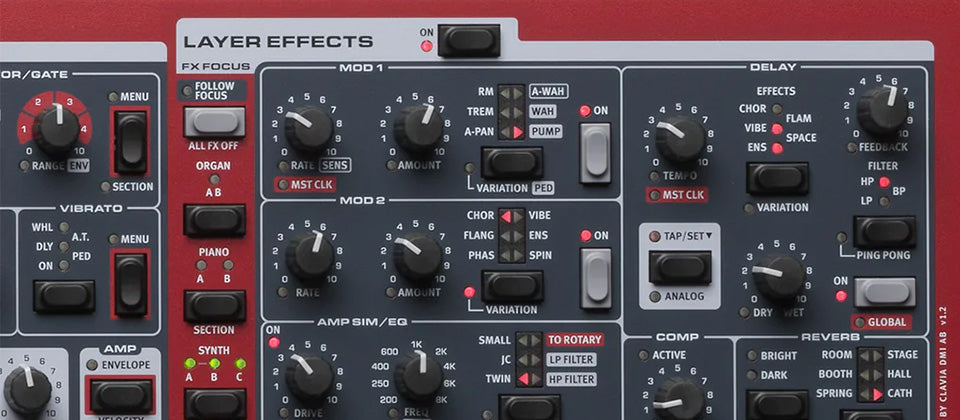
Piano Effects
Within the piano section, you'll find specific effects and parameters, including string resonance, keyboard touch, a dynamic compressor, octave shift and some preset EQ's, including a couple of Chuck Monte style Dyno EQ settings which work really nicely on the Rhodes EP voices.
Something I find especially useful with the Nord stage keyboards is that it's easy to add effects to your sound - this is especially convenient when playing a piano sound live on stage, and you need the top-end to cut through the mix a bit more, or you want to add a touch of reverb in the studio.
Nord Stage 4 Buyer's Guide for Live Performers

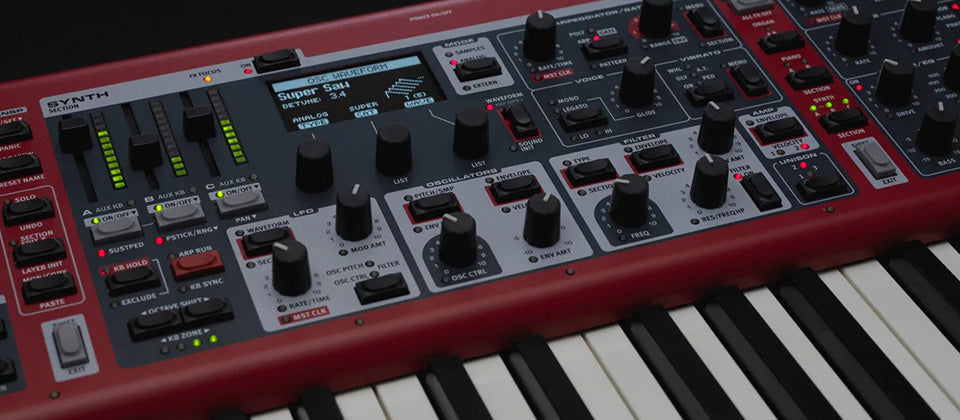
New to the Nord Stage 4 - the Preset Library
To save you from having to adjust your favourite piano settings for every single patch you want to save, new to the Nord Stage 4 is the inclusion of the Preset Library.
The buttons to access the preset library are located just above the central display screen, and this gives you access to a whole bunch of factory preset sounds for each of the sections, which can be used to combine and mix to form the basis for your own sound programs.
You can also customise and save your own presets to the preset libraries, which means you can instantly recall your favourite sounds within each of the sections. This certainly makes building your own programs much quicker than ever before.
Nord Stage 4 Buyer's Guide for Live Performers

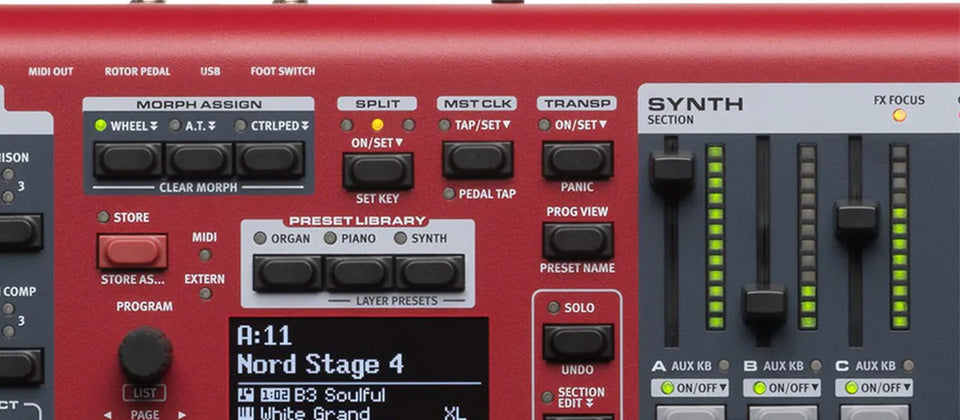
The Synth Section
The Synth Section, packed full of useful sounds, is what makes the Nord Stage 4 really stand out from other instruments in the Nord keyboard range.
The Stage 4 uses similar synthesiser architecture as the Nord Wave 2 and offers the ability to create triple-layer synth parts, which can be used to produce huge lush pad sounds, or for creating big brass parts. The older Stage 3 model only allowed two synth sounds to be layered at the same time, so this is another significant improvement.
Nord Stage 4 Buyer's Guide for Live Performers

Each of the synth layers can use either classic analogue waveforms, digital waves, FM algorithms or samples to form the basis of sound creation. As with the piano section, it is possible to import your own samples into the synth section of the Stage 4. There are lots of samples already available free of charge from the Nord Keyboards website, or you can use Nord's free sample editor software to easily construct your own sample sets, which can then be imported into the keyboard.
I would also recommend you take a look at the many Nord User Forums that you'll find online, because lots of Nord users regularly upload and share their samples, and very often, you can find exactly what you're looking for, and it saves you a whole load of work!
Another massive improvement for the Nord Stage 4 is the new Advanced polyphonic arpeggiator which now allows you to create your own rhythmic arpeggiator patterns using the onboard pattern editor. The arpeggiator can be running three completely independent patterns for the three synth parts.
Nord Stage 4 Buyer's Guide for Live Performers

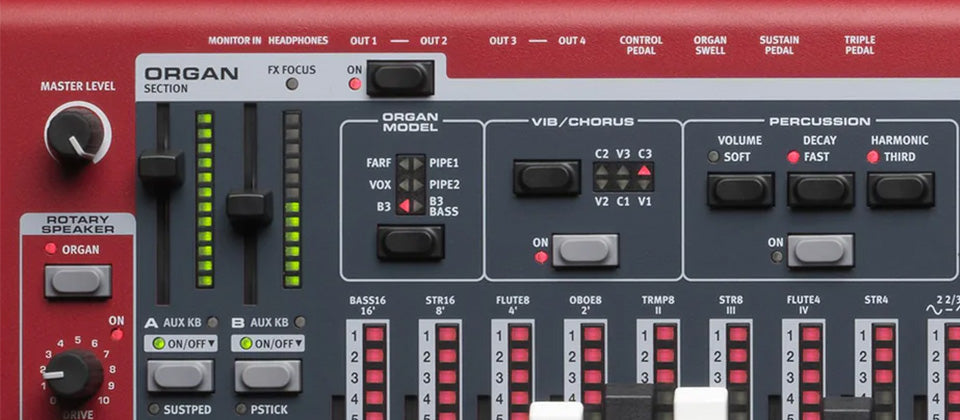
Organ Section
Nord has always been well known for offering a really competent set of organ voices in their keyboards, and the Nord Stage 4 builds on the seriousness of the organ section with the addition of a full set of nine physical drawbars available in all three keyboard models, which enable you to craft your own organ tones whilst playing live.
If you’re new to using a dedicated drawbar organ instrument, here are a few key features that will help you get started with the Nord Stage 4:
Nord Stage 4 Buyer's Guide for Live Performers

Split Keyboard Mode
As well as layering sounds, it is also possible to assign sounds to different zones of the keyboard by using the SPLIT function. Activate the SPLIT keyboard mode by pressing the SPLIT ON/SET button. You can then assign each sound part to a specific area of the keyboard using the KB ZONE buttons that you'll find within each sound section. You can also adjust the octave shift of each sound too.
If you hold down the SPLIT ON button, it is possible to activate all three split points, known as Low, Mid and High, and this allows you to divide the keyboard into a total of four distinct zones to which any Layer can be freely assigned.
As with previous Nord keyboards, the split points are preset to specific locations on the keyboard, and these are clearly indicated by little LEDs. I know that some people would prefer to have complete freedom to place the splits wherever they like on the keyboard, but having used a Nord Stage 3 in a professional setting on stage for six years, I honestly haven't yet had a problem with the predetermined split points. The LED indicators to show the split point are extremely useful on stage, and personally I am not sure that I would be comfortable going back to a keyboard that doesn't have these!
Crossfade
Each split point also has a crossfade parameter. Normally the transition between two keyboard zones is immediate, with no overlap between the sounds selected for each zone. However, by adjusting the crossFade setting for a split point, the sounds can instead be “cross-faded” across the split point with an overlap of up to six semitones, giving a smoother transition between the sounds.
A good use of the crossfade function is with one of the most-used sounds for many keyboard players - the piano & strings layer. If, like me, you like your strings to be active in the lower and mid-range of the keyboard, leaving the solo piano space to sing out on its own in the top octaves of the keyboard, this can be achieved using the split crossfade function. This is just another Nord feature that I feel shows these keyboards have been designed by musicians who have knowledge of what live performers really need in an instrument.
Nord Stage 4 Buyer's Guide for Live Performers


The Nord Stage 4 Effects Section
The effects part of the Nord Stage 4 is immensely more powerful than those featured on previous Nord keyboards, and that’s because all of the effects are available to be used on each sound part independently.
The effects section is divided up into six parts, all of which behave independently for each of the five piano & synth layers:
Two separate Modulation effects generators including wah, tremolo, auto-pan and a new effect call pump - which gives a kind of side-chain type sound. There's also a phaser, flanger, chorus, ensemble and a few other modulation effects.
Amp section effects, including a powerful graphic EQ with sweepable mid control and some vintage amp models to give your ep's, clav and synth sounds some additional dirt.
Complete delay effects section with tap tempo, a compressor to give your overall sound more presence - particularly on stage
Beautifully clean reverb effects, which can either be assigned differently for each sound section, or you can assign one global reverb effect to all sound parts.
Nord Stage 4 Buyer's Guide for Live Performers

For the organ section, there is one effects unit available to be shared by both organ parts.
One of the things I love about the new Nord Stage 4 is that there is no cut-off of the previous voices when changing programs. In some cases, I can hold on to sounds using the sustain pedal whilst changing patch, and then spend quite a long time playing the new sound, but you'll still hear the previous sound in the background. This enables you to create some massive textures of sound.
Nord Stage 4 Buyer's Guide for Live Performers

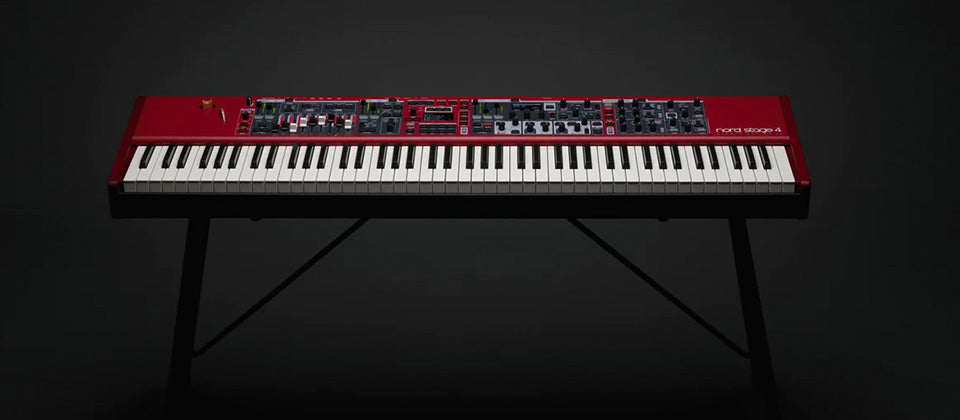
Nord Stage 4 Summary
That brings me to the end of my Nord Stage 4 demo and feature review, and I hope it has been helpful to you to help you make a decision as to whether this is the right keyboard for your needs.
If you want to test drive the Nord Stage 4 before making a purchase, we invite you to do so at one of Bonners Piano Centres. We have three stores - one on the South Coast in Eastbourne, another in Reigate in Surrey - just off Junction 8 of the M25 motorway, and a third showroom in Milton Keynes, close to the M1 and A5 roads. All our stores are out of town and have on-site parking.
Please note the first units of Nord Stage 4 models are expected to arrive in the UK towards the end of Feb 2023, but stock is expected to be very limited for the first 12 months of production, so call us first to make sure there's one available for you to try before you make the journey.
Nord Stage 4 Buyer's Guide for Live Performers

We also offer Part Exchange, so if you have a keyboard that you might want to upgrade to a Stage 4, our upgrade offers might be helpful to you and save you the hassle of selling your gear on the private market. Just email us details of the instrument/s you have to trade in, and we'll get right back to you with a valuation.
Check out our Nord Stage 4 Videos
To really appreciate the beautiful sound quality of the Nord Stage 4 and hear its features and sounds in action, check out our dedicated video below. Make sure you're listening to this video through a nice pair of headphones or monitor speakers! We've also released a Nord Stage 4 Factory Presets Demo with no talking, just playing. You can watch it here.
Nord Stage 4 Buyer's Guide for Live Performers

Watch Tony's Nord Stage 4 Buyer's Guide for Live Performers
Nord Stage 4 Buyer's Guide for Live Performers















